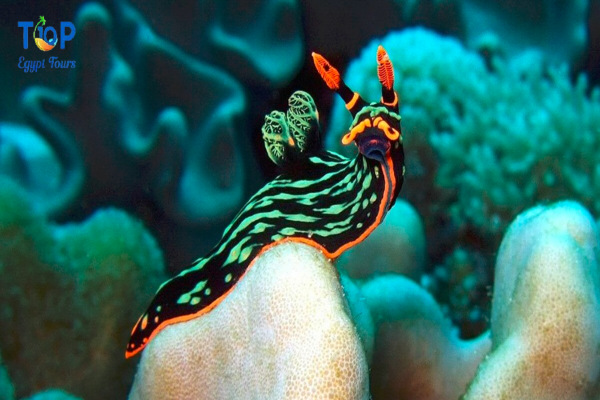nudibranchs Paradise, The Red Sea is a marine paradise, teeming with an array of vibrant marine life that captivates divers and snorkelers alike. Amongst the most captivating creatures that can be found in these crystal-clear waters are the nudibranchs, also known as sea slugs. These mesmerizing mollusks come in a dazzling array of colors and patterns, making them a true delight for underwater photographers and enthusiasts. In this blog post, we will delve into the world of nudibranchs in the Red Sea, exploring their unique features, habitats, and behaviors.
In this article, we will uncover for you the nudibranchs Paradise with Top Ten Egypt
What are nudibranchs Paradise?
Nudibranchs are a type of gastropod mollusk that have evolved to lose their shells during their life cycle. They are soft-bodied creatures that range in size from a few millimeters to over 30 centimeters. Nudibranchs are found in all oceans around the world, but they are particularly abundant in the Red Sea.
One of the most striking features of nudibranchs is their colorful and intricate patterns. These patterns serve as camouflage, warning signals, or signals for mating and communication. Some species even change color to blend in with their surroundings or to signal danger to predators.
Habitats and Behaviors
Nudibranchs can be found in a variety of habitats in the Red Sea, from shallow coral reefs to deep-sea trenches. They prefer areas with abundant food sources, such as sponges, corals, and algae. Some species are even known to feed on other nudibranchs or sea anemones.
Nudibranchs are slow-moving creatures that spend most of their time crawling along the seafloor or hiding in crevices and under rocks. They are hermaphrodites, meaning they can produce both sperm and eggs. During mating season, nudibranchs release pheromones to attract potential partners. After mating, the female lays her eggs in clusters on the seafloor or attached to a substrate.
Some species of nudibranchs have developed unique behaviors to protect themselves from predators. For example, some species release toxic chemicals from their bodies as a defense mechanism. These chemicals can be deadly to predators and even humans if ingested. Other species have evolved camouflage patterns that allow them to blend in with their surroundings and avoid detection by predators.
Examples of nudibranchs Paradise Species in the Red Sea
The Red Sea is home to over 150 species of nudibranchs, making it one of the most diverse regions for these fascinating creatures. Here are just a few examples of some of the most stunning nudibranch species that can be found in these waters:
1) Glaucus atlanticus – This blue dragon nudibranch is one of the most iconic species found in the Red Sea. It is known for its striking blue coloration and long trailing tentacles that resemble a dragon’s tail. Glaucus atlanticus feeds on other nudibranchs and sea anemones and is venomous to humans due to its toxic diet.
2) Phyllidia ocellata – This sea slug is known for its striking yellow and black coloration with distinctive black spots resembling eyes. It feeds on sponges and is often found hiding in crevices or under rocks during the day. Phyllidia ocellata is also venomous to humans due to its diet of toxic sponges.
3) Chromodoris reticulata – This red-spotted sea slug has a bright red body with distinctive white spots arranged in a reticulated pattern. It feeds on sponges and is often found crawling along the seafloor or hiding under rocks during the day. Chromodoris reticulata is not venomous to humans but can release toxic chemicals as a defense mechanism against predators.
Conclusion: Exploring Nudibranch Paradise in the Red Sea
The Red Sea is truly a nudibranch paradise, teeming with an array of colorful and fascinating creatures that continue to captivate divers and snorkelers alike. From blue dragons to red-spotted sea slugs, these mesmerizing mollusks offer a glimpse into the wondrous world of marine life found in these crystal-clear waters. By exploring their habitats, behaviors, and unique features, we can gain a deeper appreciation for these delicate creatures and work towards preserving their natural habitats for future generations to enjoy. So why not dive into this nudibranch paradise and discover the beauty and mystery of these captivating creatures for yourself?
Browse our complete list of Egypt tours Click Here



Comment (0)